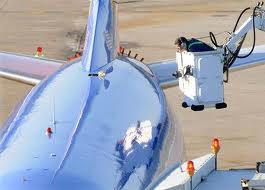|
|||||||||||
|
|
|
|||
|
By Bill Goldston |
||||
 |
August 24, 2010 -
Southwest Airlines (SWA) Flight 2294 departed
The aircraft was
scheduled to land at |
|||
|
|
||||
|
The flight data recorder data revealed that the airplane took off and climbed for about 25 minutes to an altitude of approximately 35,000 feet. At that point, the cabin altitude warning activated, and the captain disengaged the autopilot and began a descent. The altitude warning ceased as the airplane descended through approximately 9,000 feet. Cockpit voice recorder data and post incident interviews revealed that the flight and cabin crewmembers followed appropriate cockpit procedures following the rapid decompression and during the emergency descent and landing at CRW.
A three-sided hole
(flap) was located in skin assembly in the fuselage crown skin near the
leading edge of the vertical stabilizer and measured about 17.4 inches
longitudinally and between 11.5 and 8.6 inches circumferentially.
The captain had
accumulated 22,500 total flight hours, 19,300 hours of which were in the
737. He held an airline transport pilot (ATP) certificate and a class
one medical certificate with a limitation/waiver for corrective lenses. |
||||
|
Skin assembly parts are made of an outer sheet of skin, which covers the entire assembly, and a waffle-pattern doubler sheet hot bonded to the inner surface of the part. Both pieces were 0.036-inch-thick, 2024?T3 clad aluminum sheets. Boeing indicated that the skin assembly was manufactured by forming and bonding two full sheets together, then selectively masking and chemically milling away pockets (bays) of the inner doubler sheet to create a waffle pattern. The bay immediately adjacent to the rupture is not chemically milled to provide for possible installation of an emergency locator transponder (ELT) antenna.
Magnified
inspections of the fracture surface of the skin assembly part revealed
bright faceted surfaces indicative of fatigue progress along the
longitudinal section of the flap, which followed the chemically milled
edge of the adjacent doubler. The circumferential crack regions
displayed matte grey slant fracture surfaces and bulk deformation
patterns indicative of overstress tearing away from the longitudinal
portion of the crack.
The visual depth
of the fatigue regions varied along the crack length. Near the middle of
the longitudinal crack, the fatigue crack appeared to completely
penetrate the skin thickness for a distance of approximately 3 inches.
Scanning electron microscope examinations clearly showed microscopic
features typical of fatigue progression, including areas of striations,
in the longitudinal crack region.
However, Boeing
finite element modeling suggests stress levels are higher in the skin at
the edges of chemically milled steps adjacent to non-chemically milled
bays due to the difference in stiffness. |
|
|
| Other News Stories |
| ?AvStop
Online Magazine
Contact
Us
Return To News
|
|


